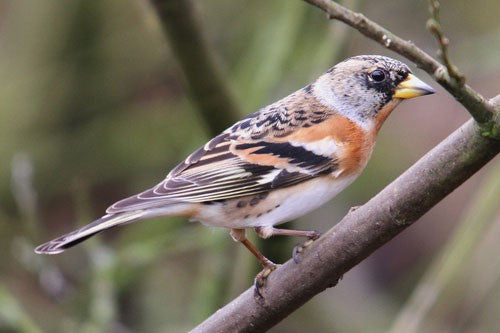
Brambling Bird: Identification, Migration, and Feeding Tips
Share
The Brambling (Fringilla montifringilla) is similar in size and shape to the Chaffinch. It is recognised by its russet-coloured upper-breast and white rump, the male having a black head with the female's being mottled black and brown. Their backs are dark brown and they have white wing-bars.
The Brambling is a winter bird and you can expect to see them between the months of September and April but occasionally the birds will stay in the UK until May, and then they will migrate to Scandinavia or West Siberia for the breeding season.
In some years, when breeding has been very successful, 'invasions' of huge flocks descend on beech woods to feed and - when this food is no longer available - they will come to garden feeding stations. They will accompany Chaffinches and other seed-eaters, feeding on seed that’s found its way onto the ground (often it’s dropped from a bird seed feeder).
The Bramblings diet largely consists of fruit and seeds and they can be found in agricultural fields near woods. They are especially attracted to beech trees and hornbeams where it gorges on seeds which have fallen to the ground.
They can also be found closer to home, as they do tend to visit gardens, and there is a high chance you may spot one visiting your bird feeders.
They take sunflower seed, especially the black variety, and will pick through any of the Haith’s wild bird foods, especially when the ground becomes snow-covered.
Huskfree Advance with Dried Mealworms, for one good example, is a 100% edible bird food with high-fat dried mealworms leaves no waste to clear up and has more protein than Huskfree Advance. It's packed with extra goodness to help busy parent birds and fledglings make it through the breeding season and through the autumn/winter seasons, year-round goodness.
The Brambling has a wheezy song which is very similar to the Greenfinch; its pitch varies less and is rarely heard in Britain.
The Brambling has no conservation measures in place and has, therefore, a Green Status here in the UK, which means it's an abundant species and is not considered to be threatened with extinction.
Winter is a great time to watch the birds; sometimes you can see them in spectacular numbers and flashes of colour and each with a different character. Some are coy whilst other gregarious by nature - all are welcome at a busy bird feeding station. Birds expand relatively large amounts of energy searching for food and it's up to us, collectively, to make sure they eat enough so they can maintain adequate fat supplies to make it through to spring.

Written by Tina Jakes
